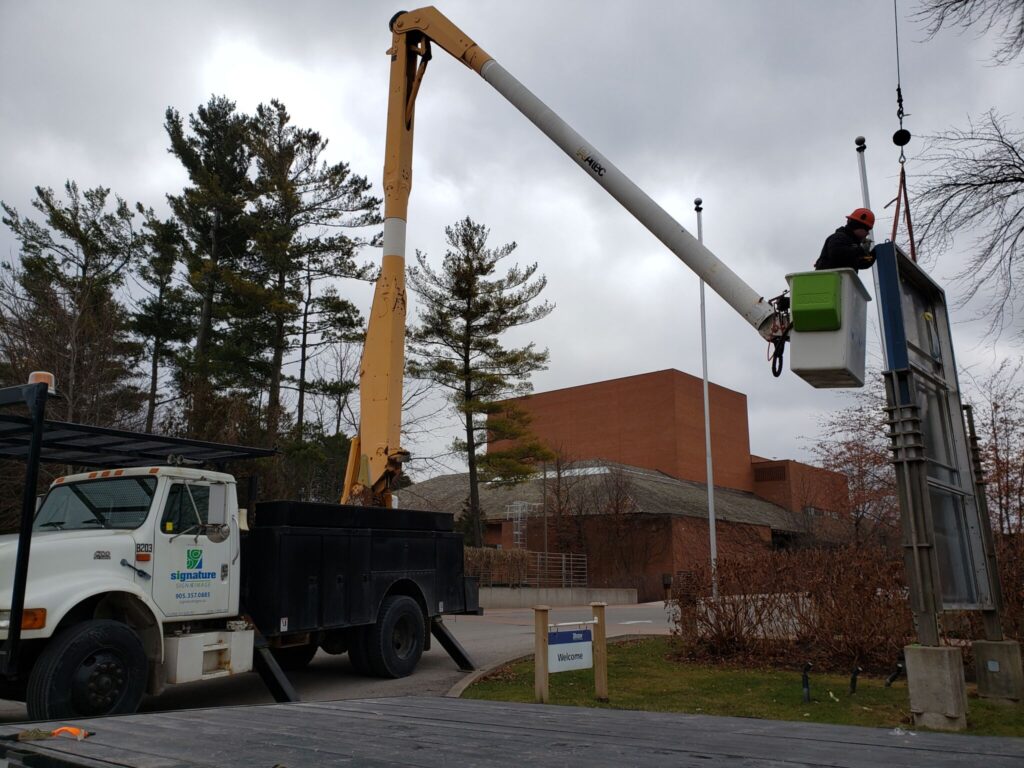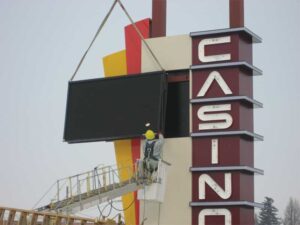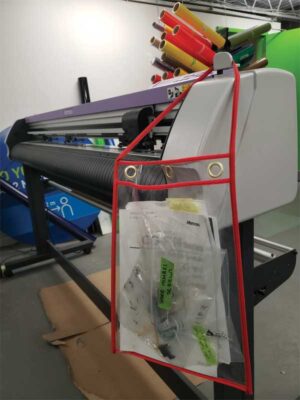Taking things in-house: What every sign shop needs to know to be self-sufficient
by all | 6 May 2021 11:08 pm
By Mark Wallis
 [1]
[1]Many sign shops have found great success and control on their projects by owning their installation equipment.
Today, it seems everyone is pivoting their businesses to become a turnkey solution. If one cannot fully complete a project internally, they are forced to outsource, subcontract, rent (machines), or hire more staff. This poses a problem for many as they do not have the equipment or resources to support their workload internally.
When it comes to deciding on subcontractors, rental equipment, or outsourcing tasks and/or responsibilities, there are a variety of pros and cons sign shops must consider.
Subcontractors
Con: Can become expensive if problems occur during installation, fabrication, etc.
Con: More work is potentially required to ensure the quality meets the businesses’ standards.
Con: Unpredictable timelines. If the project is not a priority to the subcontractor, they may delay an install, which can not only become stressful for the client, but also a sign shop’s scheduling team.
Pro: No increase on the company’s payroll.
Pro: If it is a subcontractor-related issue, warranty work should not be a cost incurred by the sign shop.
Pro: Pricing can be quoted into the job so there are no surprises.
 [2]
[2]By having greater control over its products, sign shops take pride in the fact a large percentage of their work is produced directly by their skilled staff and operating equipment.
Rental equipment
Con: Expensive one-time fee.
Con: Potentially unreliable, i.e. damaged by previous renter and not caught by rental company, causing hours of lost time to replace.
Con: Dangerous, most rental companies will let customers rent any type of equipment even without proper experience. This can be very dangerous for unskilled employees who ‘think they can handle it.’
Con: Rentals extending past their intended pick-up time can become costly (if a problem occurs and the unit is needed for more than what was costed.)
Pro: No maintenance costs.
Pro: Free return if there is an issue with
the equipment.
Pro: No storage needed for the equipment.
Pro: Pickup, drop-off, and rental can be accurately priced to a client.
 [3]
[3]It is also important to keep maintenance logs with the equipment to see when the last check was made, or the last oil change occurred.
Outsourcing (printing, bending, fabrication, etc.)
Con: Expensive (less profit margin).
Con: Unpredictable timelines (at mercy of wholesaler).
Con: Quality control happens after the product is received in-house. If the wholesaler misses a quality check and it arrives at the sign shop ready to be installed, finding an issue at this point can be troublesome. Typically, the turnaround time to fix the issue(s) is not quick.
Pro: Less overhead costs (project management only).
Pro: The ability to reach out to more than one wholesaler to increase workload (although higher workloads does not necessarily mean higher profit margins).
With these pros and cons in mind, before one purchases or leases new equipment, they should draw up a comparative report from their previous three to five years without the equipment and forecast the next three to five years with the equipment. Also, one should ask themselves a few questions such as:
- Who will be operating the new machines?
- Will the sign shop need to hire more people to operate the equipment? (How much time will this take to learn/train?)
- What are the maintenance costs? (Can the equipment be fixed in-house or will one need to hire a technician to repair?)
- What does the upkeep involve? (e.g. oil changes, belt replacement, chains, blades, etc.)
- Does the sign shop have enough power to run this new equipment? (computer numerical control [CNC] machines and 3D printers, for example, can require high power demand)
- What other pieces of equipment will be required to operate the new purchase? (e.g. air compressors, pumps, filters, etc.)
- What safety-related issues will one run into? (What type of planning is necessary should something go wrong?)
- Does the shop have the space to accommodate the equipment? (Will valuable operating space be lost?)
- What is the depreciating value factor of the machine? (Can the equipment be resold without taking too much of a hit if it does not work out?)
 [4]
[4]The person checking the equipment should sign their name in the maintenance log as it not only keeps them accountable, but also puts less strain on the shop owner knowing the equipment is being checked and the need for costly repairs are less likely.
After answering these questions, a sign shop owner should then prepare a cost analysis of what it would cost to hire someone to make a sign without having to purchase the equipment versus what it would cost to make the sign entirely in-house. The cost should then be multiplied by the shop’s forecasted sales (using the machines) to see how long it will take to pay them off.
This formula will differ from shop to shop as everyone likes to operate differently. That said, this author has found great success and control with owning their equipment—whether it be trucks, augers, tractors, trailers, printers, CNC machines, channel letter benders, paint booths, etc. By operating in this fashion, the author’s company has greater control over its product and takes pride in the fact a large percentage of the shop’s work is produced directly by their skilled staff and operating equipment.
Maintenance on equipment
As many in the sign industry are aware, equipment maintenance can be hard on the pocketbook. Some shops do not have the time to fix the equipment on their own, while others may be worried about their ability to repair it properly and if it is even safe for them to do so.
These are all great questions to ask; however, it is important to step back and think about the problem, how hard can it be to repair, and can someone on staff be trained to do this work? The answer is yes. This is a trainable skill. Keep in mind, the author is not talking about an engine rebuild or an electrical diagnosis but, rather, simple maintenance such as greasing fittings, changing the oil on trucks and equipment, checking and changing filters, inspecting leaks and tightening loose connections, and replacing cables and belts. The internet (YouTube in particular) is an extremely valuable resource for these types of repairs.
 [5]
[5]When one learns how to maintain a certain piece of equipment, they should record the step-by-step procedures in a booklet and attach it to the machine, so it is quick to find and easy to understand.
Another good idea for sign shops is to create a training procedure for any type of repair, along with a schedule of required maintenance, and present it to staff. This is a good time to see who is interested in becoming the company repair person. This does not have to be a full-time job, but it can be an extremely valuable asset to the company to have one of its employees take on this role. Not only will this increase their understanding for how something works, but it will also increase their motivation to keep the equipment in working order and operating efficiently, which is something they can take pride in.
A great example of how this can improve one’s skills and understanding is if they know how to change the oil in the company’s trucks, compressors, and pumps etc., they are learning a life skill they can apply at home. Using the knowledge gained from their job, one can change their own oil at home to save time and money. In doing so, one also gains more appreciation for the company for helping them save on their bottom line, too.
When one learns how to maintain a certain piece of equipment, they should record the step-by-step procedures in a booklet and attach it to the machine or keep it with the equipment so it is quick to find and easy to understand. This way, if the shop’s in-house repair person is not available, or a new staff member wants to step up and help with the maintenance, the booklet is there and ready to go.
It is also important to keep maintenance logs with the equipment to see when the last check was made, or the last oil change occurred. Shop owners should set reminders for themselves and their staff to monitor equipment regularly. In doing so, the person checking the equipment should sign their name in the maintenance log as it not only keeps them accountable, but also puts less strain on the owner knowing the equipment is being checked and the need for a costly repair is minimalized.
Maximize profits by expanding employee knowledge
When it comes to a sign shop owning its equipment, there is also the need to have training protocols in place for every machine. This can be considered both a pro and a con. Yes, training takes a lot of time, patience, and confidence. This can be painstaking and costly but, in the long run, the sign shop is adding valuable skills to its team, which can translate into greater job performance, better problem-solving skills, and increased confidence in the task at hand.
The term ‘spend money to make money’ rings true. Every sign shop owner knows how much time and money it takes to train staff properly—especially when third-party training is encouraged. Whether it be brushing up on an accounting program, taking a course on a new 3D rendering software, or taking a skilled driving course to upgrade one’s license to operate a DZ-rated truck, by trusting the staff’s ability to retain this new knowledge and allowing them to exercise their new skills and share it with other employees, it can not only help a business grow, but also reach new achievements that were once unattainable.
Further, some sign shops may be able to reduce the number of subcontractors it was using prior to its staff becoming more proficient and confident in their new abilities. Some may also find they have more lead hands and less general labourers and, as a result, it could potentially allow a sign shop to handle an increased workload at a reduced operating cost because there is no longer a need to rent equipment, hire subcontractors, or outsource. By having more equipment in the shop, some staff may even gravitate to a new skill they never knew they would be able to possess, which can give them more appreciation for their job.
It is all about keeping staff and new equipment productive. One should look at their equipment as they would an employee, whereby making sure they are always as productive as possible. If the business is not operating at 100 per cent, sign shop owners should not only ask themselves why, but also what it is they can do to increase productivity. One may find they may need to adjust their sales targets at any given time to offset the loss of productivity.
Mark Wallis is one of the owners of Signature Sign & Image[6] in Niagara Falls, Ont. He is also the director of safety and installations for the Young Professionals Network (YPN). Wallis can be contacted via email at mark@signaturesigns.ca. For more information on the YPN, follow the group on Instagram @ypncanada.
- [Image]: https://www.signmedia.ca/wp-content/uploads/2021/05/Signature_Sign_Image_20200129_131923-scaled.jpg
- [Image]: https://www.signmedia.ca/wp-content/uploads/2021/05/Blanchett_Neon_IMG_0865.jpg
- [Image]: https://www.signmedia.ca/wp-content/uploads/2021/05/20200902_153358.jpg
- [Image]: https://www.signmedia.ca/wp-content/uploads/2021/05/20200902_153349.jpg
- [Image]: https://www.signmedia.ca/wp-content/uploads/2021/05/20200902_153102.jpg
- Signature Sign & Image: http://www.signaturesigns.ca/07_Application/01_Home.php
Source URL: https://www.signmedia.ca/taking-things-in-house-what-every-sign-shop-needs-to-know-to-be-self-sufficient/